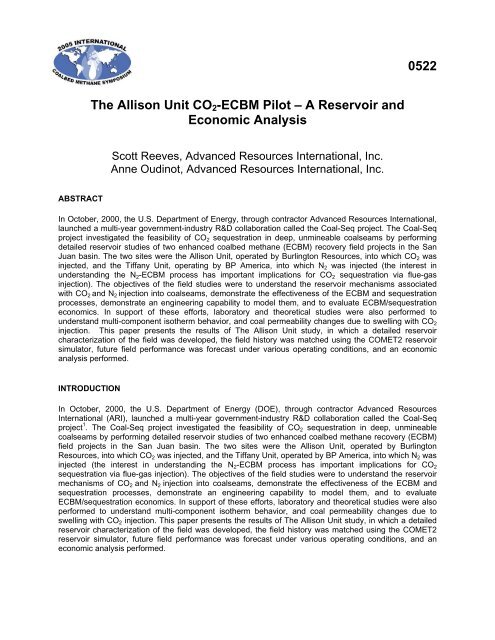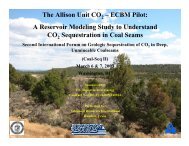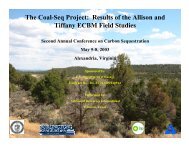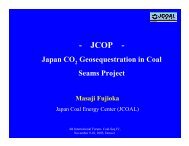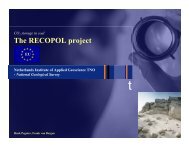The Allison Unit CO2-ECBM Pilot - A Reservoir and ... - Coal-Seq
The Allison Unit CO2-ECBM Pilot - A Reservoir and ... - Coal-Seq
The Allison Unit CO2-ECBM Pilot - A Reservoir and ... - Coal-Seq
You also want an ePaper? Increase the reach of your titles
YUMPU automatically turns print PDFs into web optimized ePapers that Google loves.
0522<br />
<strong>The</strong> <strong>Allison</strong> <strong>Unit</strong> CO 2 -<strong>ECBM</strong> <strong>Pilot</strong> – A <strong>Reservoir</strong> <strong>and</strong><br />
Economic Analysis<br />
Scott Reeves, Advanced Resources International, Inc.<br />
Anne Oudinot, Advanced Resources International, Inc.<br />
ABSTRACT<br />
In October, 2000, the U.S. Department of Energy, through contractor Advanced Resources International,<br />
launched a multi-year government-industry R&D collaboration called the <strong>Coal</strong>-<strong>Seq</strong> project. <strong>The</strong> <strong>Coal</strong>-<strong>Seq</strong><br />
project investigated the feasibility of CO 2 sequestration in deep, unmineable coalseams by performing<br />
detailed reservoir studies of two enhanced coalbed methane (<strong>ECBM</strong>) recovery field projects in the San<br />
Juan basin. <strong>The</strong> two sites were the <strong>Allison</strong> <strong>Unit</strong>, operated by Burlington Resources, into which CO 2 was<br />
injected, <strong>and</strong> the Tiffany <strong>Unit</strong>, operating by BP America, into which N 2 was injected (the interest in<br />
underst<strong>and</strong>ing the N 2 -<strong>ECBM</strong> process has important implications for CO 2 sequestration via flue-gas<br />
injection). <strong>The</strong> objectives of the field studies were to underst<strong>and</strong> the reservoir mechanisms associated<br />
with CO 2 <strong>and</strong> N 2 injection into coalseams, demonstrate the effectiveness of the <strong>ECBM</strong> <strong>and</strong> sequestration<br />
processes, demonstrate an engineering capability to model them, <strong>and</strong> to evaluate <strong>ECBM</strong>/sequestration<br />
economics. In support of these efforts, laboratory <strong>and</strong> theoretical studies were also performed to<br />
underst<strong>and</strong> multi-component isotherm behavior, <strong>and</strong> coal permeability changes due to swelling with CO 2<br />
injection. This paper presents the results of <strong>The</strong> <strong>Allison</strong> <strong>Unit</strong> study, in which a detailed reservoir<br />
characterization of the field was developed, the field history was matched using the COMET2 reservoir<br />
simulator, future field performance was forecast under various operating conditions, <strong>and</strong> an economic<br />
analysis performed.<br />
INTRODUCTION<br />
In October, 2000, the U.S. Department of Energy (DOE), through contractor Advanced Resources<br />
International (ARI), launched a multi-year government-industry R&D collaboration called the <strong>Coal</strong>-<strong>Seq</strong><br />
project 1 . <strong>The</strong> <strong>Coal</strong>-<strong>Seq</strong> project investigated the feasibility of CO 2 sequestration in deep, unmineable<br />
coalseams by performing detailed reservoir studies of two enhanced coalbed methane recovery (<strong>ECBM</strong>)<br />
field projects in the San Juan basin. <strong>The</strong> two sites were the <strong>Allison</strong> <strong>Unit</strong>, operated by Burlington<br />
Resources, into which CO 2 was injected, <strong>and</strong> the Tiffany <strong>Unit</strong>, operated by BP America, into which N 2 was<br />
injected (the interest in underst<strong>and</strong>ing the N 2 -<strong>ECBM</strong> process has important implications for CO 2<br />
sequestration via flue-gas injection). <strong>The</strong> objectives of the field studies were to underst<strong>and</strong> the reservoir<br />
mechanisms of CO 2 <strong>and</strong> N 2 injection into coalseams, demonstrate the effectiveness of the <strong>ECBM</strong> <strong>and</strong><br />
sequestration processes, demonstrate an engineering capability to model them, <strong>and</strong> to evaluate<br />
<strong>ECBM</strong>/sequestration economics. In support of these efforts, laboratory <strong>and</strong> theoretical studies were also<br />
performed to underst<strong>and</strong> multi-component isotherm behavior, <strong>and</strong> coal permeability changes due to<br />
swelling with CO 2 injection. This paper presents the results of <strong>The</strong> <strong>Allison</strong> <strong>Unit</strong> study, in which a detailed<br />
reservoir characterization of the field was developed, the field history was matched using the COMET2<br />
reservoir simulator, future field performance was forecast under various operating conditions, <strong>and</strong> an<br />
economic analysis performed.
2<br />
THE ALLISON UNIT CO 2 -<strong>ECBM</strong> PILOT – A RESERVOIR AND ECONOMIC ANALYSIS<br />
SITE DESCRIPTION<br />
<strong>The</strong> <strong>Allison</strong> <strong>Unit</strong> <strong>ECBM</strong> pilot is located in San Juan County, southern New Mexico, in close proximity to<br />
the border with Colorado (Figure 1). While the <strong>Unit</strong> consists of many wells, the pilot area for CO 2 injection<br />
consisted of 16 coalbed methane (CBM) producer wells, 4 CO 2 injectors, <strong>and</strong> one pressure observation<br />
well (POW #2). <strong>The</strong> study area well pattern is illustrated in Figure 2. At the center of the study area is a<br />
five-spot of CBM producers on nominal 320 acre spacing (wells 130, 114, 132 <strong>and</strong> 120 at the corners,<br />
<strong>and</strong> well 113 in the center), with the four CO 2 injectors roughly positioned on the sides of the five-spot<br />
between the corner producer wells (creating a nominal 160 acre spacing between injectors <strong>and</strong><br />
producers). POW #2 is located on the eastern border of the central pattern, <strong>and</strong> the remaining CBM<br />
producers surround this central pattern.<br />
<strong>The</strong> producing history for the study area is shown in Figure 3. <strong>The</strong> field originally began production in<br />
1989, with CO 2 injection occurring between April, 1995 <strong>and</strong> August, 2001. Several points are worth<br />
making regarding the producing history:<br />
o<br />
o<br />
Upon commencement of the injection operations, the five producer wells in the central five-spot<br />
pattern were shut in. <strong>The</strong> purpose was to facilitate CH 4 /CO 2 exchange in the reservoir. After<br />
about six months, CO 2 injection was suspended for about another six months, during which time<br />
the five shut-in producers were re-opened. <strong>The</strong>se activities can be clearly identified in Figure 3;<br />
their impact on long-term production performance however, if any, is unclear.<br />
Shortly after CO 2 injection began, a program of production enhancement activities unrelated to<br />
the CO 2 -<strong>ECBM</strong> pilot was implemented. Those activities included well recavitations, well<br />
reconfigurations (conversion from tubing/packer completions to annular flow with a pump installed<br />
for well dewatering), line pressure reductions due to centralized compression, <strong>and</strong> also the<br />
installation of on-site compression. <strong>The</strong>se activities largely coincided with the dramatic increase in<br />
production observed beginning in mid-1998.<br />
In addition, a plot of injection rate <strong>and</strong> pressure history for injector well # 143 is shown in Figure 4.<br />
Injection was performed at a constant surface pressure, <strong>and</strong> rate was allowed to vary. Note the reduction<br />
in injection rate during early time, presumably due to coal swelling <strong>and</strong> permeability reduction. <strong>The</strong><br />
rebound in injectivity during later times is believed due to overall reservoir pressure reduction <strong>and</strong><br />
resulting matrix shrinkage that occurred near the injector wells.<br />
RESERVOIR DESCRIPTION<br />
<strong>The</strong> <strong>Allison</strong> <strong>Unit</strong> wells produce from three Upper Cretaceous Fruitl<strong>and</strong> Formation coal seams, named the<br />
Yellow, Blue <strong>and</strong> Purple (from shallowest to deepest) using Burlington Resources’ terminology. A<br />
summary of basic coal depth, distribution, thickness, pressure, <strong>and</strong> temperature information is provided in<br />
Table 1.<br />
Sorption isotherms for both CH 4 <strong>and</strong> CO 2 were measured for six coal samples taken from three wells<br />
within the study area. Average CH 4 <strong>and</strong> CO 2 isotherms based on these data for each coal interval, on a<br />
raw basis <strong>and</strong> at an average density of 1.5 grams per cubic centimeter (g/cc), are shown in Figures 5 <strong>and</strong><br />
6.<br />
In May, 2000, pressure buildup tests were performed on 12 wells in the <strong>Allison</strong> <strong>Unit</strong>, eight of which were<br />
inside the study area. Analysis of these data provided estimates of effective gas permeability, skin factor,<br />
<strong>and</strong> reservoir pressure. Two adjustments of the results were made to 1) derive absolute permeability from<br />
the effective gas permeability results <strong>and</strong> 2) correct to initial conditions – accounting for both pressuredependent<br />
permeability <strong>and</strong> matrix shrinkage. <strong>The</strong> resulting permeability map of the field is shown in<br />
Figure 7. Permeability values ranged from 30-150 millidarcies (md), with higher permeabilities
3<br />
REEVES, OUDINOT<br />
concentrated within the central 5-spot pattern. No permeability anisotropy appeared to exist for the study<br />
area.<br />
A novel technique was also used to estimate relative permeability <strong>and</strong> porosity for the study area based<br />
on historical gas <strong>and</strong> water production. This technique, described in a detailed report on the <strong>Allison</strong> <strong>Unit</strong> 2 ,<br />
provided average relative permeability curves for the study area, as well as a porosity map.<br />
RESERVOIR MODEL CONSTRUCTION<br />
<strong>The</strong> reservoir simulator used for the study was ARI’s COMET2 (binary isotherm – CH 4 <strong>and</strong> CO 2 ) model.<br />
Details on the model theory are provided in the references 3,4 .<br />
A three-layer (Yellow, Blue, Purple), full-field model was constructed. <strong>The</strong> coal structure <strong>and</strong> thickness<br />
information for each layer was directly input per the maps generated. <strong>Coal</strong> permeability <strong>and</strong> porosity<br />
maps were similarly employed. Relative permeability curves from the analysis mentioned previously, as<br />
well as the laboratory isotherms, were also used.<br />
Additionally, well completion <strong>and</strong> operating parameters were examined for input into the model, such as<br />
recavitations, well reconfigurations <strong>and</strong> producing pressure adjustments. This was particularly important<br />
given the complexity of the field history, <strong>and</strong> the desire to isolate <strong>and</strong> study the effects of CO 2 injection.<br />
<strong>The</strong> model gridblock dimensions were 33 x 32 x 3 (approximately 3,200 total grid blocks, 2,600 of which<br />
were active), <strong>and</strong> covered an active area of about 7,100 acres (Figure 8). On average, the gridblock<br />
dimensions were 560 feet x 525 feet x 14 feet. <strong>The</strong> corners of the model were isolated using no-flow<br />
barriers to account for producing wells immediately adjacent to these portions of the study area.<br />
HISTORY MATCH RESULTS<br />
<strong>The</strong> independent parameter used for the simulator was gas production (<strong>and</strong> injection) rate to maintain<br />
material balance, <strong>and</strong> the dependent (history match) parameters were water production rate, flowing<br />
pressure (producing <strong>and</strong> injecting), <strong>and</strong> gas composition. Note that only some of these data were<br />
available for some periods for some wells; whatever was available was used. In addition, the pressure<br />
history at POW #2 was available.<br />
All parameters were modified globally to obtain the best overall match for the field. <strong>The</strong> objective of the<br />
study was to underst<strong>and</strong> the mechanisms of the CO 2 -<strong>ECBM</strong> process by matching general trends, <strong>and</strong> not<br />
necessarily to make regional changes to the reservoir characterization to achieve matches on an<br />
individual well basis. While a large number of simulation trials were performed varying almost all<br />
significant reservoir parameters, it was ultimately found that the original reservoir characterization seemed<br />
to provide the best overall result.<br />
A comparison of the actual versus simulated field gas rate is presented in Figure 9. <strong>The</strong> only conclusion<br />
that can be derived from this result, since the model was “driven” on gas rate, is that model (as<br />
constructed) was capable of delivering the gas volumes required.<br />
<strong>The</strong> actual versus simulated pressure at POW#2 is presented in Figure 10. Actual pressure data is only<br />
available after the commencement of CO 2 injection. At that particular point in time (April, 1995), there<br />
appears to be excellent agreement between actual <strong>and</strong> predicted pressure, suggesting that material<br />
balance (at least during primary production) was achieved, <strong>and</strong> hence values for original gas/water<br />
storage capacities, as well as depletion characteristics, were reasonable. After that, however, there is<br />
considerable difference in pressure values. Of note is that the estimated pressure at the location of POW<br />
#2 based on the May, 2000 pressure transient analysis (PTA) is reasonably close to the simulated value.<br />
After considerable analysis of the discrepancy it is believed that the pressure data recorded at POW#2
4<br />
THE ALLISON UNIT CO 2 -<strong>ECBM</strong> PILOT – A RESERVOIR AND ECONOMIC ANALYSIS<br />
may have been influenced by severe restrictions in wellbore-reservoir connectivity, <strong>and</strong> therefore may not<br />
have been valid.<br />
Comparison plots of gas <strong>and</strong> water rates, flowing pressures, <strong>and</strong> produced gas compositions, for well 113<br />
are presented in Figure 11. This well was selected because it was the central well of the 5-spot, it had<br />
data for comparison in all categories, <strong>and</strong> it had observable CO 2 breakthrough. In addition, this well<br />
typifies the differences in simulated versus actual results for the other wells. Several general comments<br />
can be made regarding the results:<br />
o<br />
<strong>The</strong> quality of the water rate predictions varied, with some being too high <strong>and</strong> some too low.<br />
However, on balance the predictions were considered within reason (<strong>and</strong> that could be easily<br />
“fixed” with regional variations in porosity <strong>and</strong>/or water relative permeability).<br />
o In all cases, the predicted bottomhole flowing pressures were higher than the measured values –<br />
which were actually surface casing pressure data – usually by 200-300 psi. While some<br />
difference might be expected due to the different types of data being compared (surface vs.<br />
downhole), the magnitude of the difference seems large. (<strong>The</strong> wells were believed to be pumpedoff<br />
with little water head existing above the coal seam.) In most cases the predicted flowing<br />
pressures appear smooth through the period when the recavitation operations were performed.<br />
This result was per the model design.<br />
o<br />
In general, the trend in gas composition was reasonably well replicated. In some cases (most<br />
noteworthy well #113), the increase in CO 2 content of the produced gas occurs more rapidly than<br />
that actually observed.<br />
A comparison of actual to simulated bottomhole injection pressures for CO 2 injector well #142 is provided<br />
in Figure 12. Note that the results for the other three injector wells were very similar. <strong>The</strong> actual<br />
bottomhole pressure history data was computed using long-term surface pressure data, <strong>and</strong> flowing<br />
pressure gradients obtained during the August, 2001 injection/falloff tests. <strong>The</strong> simulated pressures are<br />
considerably lower than the actual values. While simulated bottomhole pressures could be increased<br />
substantially to better match the actual data by assuming lower initial permeability values for the injector<br />
well gridblocks, the objective was to see if the coal swelling formulation in the simulator could adequately<br />
account for sufficient permeability reduction to achieve the high injection pressures observed. <strong>The</strong> result<br />
suggests that the answer is negative. <strong>The</strong>refore, coal swelling models with CO 2 injection may require<br />
further development to adequately replicate field data.<br />
Pressure transient tests performed in August, 2001 in the CO 2 injection wells indicated near-well<br />
permeabilities of
5<br />
REEVES, OUDINOT<br />
For each <strong>ECBM</strong> forecast case, an economic limit of 50 Mcfd of methane per well <strong>and</strong> 50% CO 2 content<br />
per well was imposed; reaching those thresholds prompted the well in question to be shut-in in the model.<br />
Results of the forecast for the actual pilot conditions indicated that of the 6.4 Bcf of CO 2 injected in the<br />
pilot area, 1.6 would ultimately be reproduced. <strong>The</strong> incremental methane recovery was 1.6 Bcf, yielding a<br />
net CO 2 /CH 4 ratio of 3.0. Figure 14 presents the simulated sweep of the CO 2 at the end of the forecast<br />
period for the pilot. Note that excellent sweep appears to have been achieved in the northern, western,<br />
<strong>and</strong> southern quadrants of the five-spot. However, due to the location of injection well #140, poor sweep<br />
was achieved in the eastern quadrant.<br />
Since the model area was so large compared to the actual flooded area, the incremental recovery results<br />
were examined for each quadrant of the central 5-spot pattern. Methane recoveries with <strong>and</strong> without CO 2<br />
injection were computed for each quadrant <strong>and</strong> are presented in Table 3. This analysis indicates that<br />
CO 2 -<strong>ECBM</strong> was highly effective at recovering incremental methane, providing on the order of 17 – 18% of<br />
original-gas-in-place where the patterns were configured for effective sweep.<br />
Two additional interesting observations were made regarding the modeling results:<br />
• <strong>The</strong> stabilized CO 2 /CH 4 ratio of about 3:1 is higher than normally cited for San Juan basin coals.<br />
However, if one examines the ratio as a function of pressure (based on the isotherms) the results<br />
are as expected (Figure 15). At an ab<strong>and</strong>onment pressure of ~50 psi, the CO 2 /CH 4 ratio is close<br />
to 3:1.<br />
• It appears that some time was required after CO 2 injection ceased for the CO 2 to migrate through<br />
the reservoir <strong>and</strong> displace the “equilibrium” volume of methane. Figure 16 illustrates the<br />
CO 2 /CH 4 ratio over time for the pilot. Note that the ratio increases during injection periods (<strong>and</strong><br />
for some time afterwards), <strong>and</strong> then begins a gradual decline to the equilibrium value.<br />
ECONOMIC ASSESSMENT<br />
<strong>The</strong> final element of the study was to evaluate the economic performance of the pilot. <strong>The</strong> capital,<br />
operating <strong>and</strong> financial assumptions are presented in Table 3. Note that all economics were performed<br />
on an incremental basis (i.e., only the incremental production <strong>and</strong> costs were considered). Further, the<br />
effect of Section 29 tax credits was not considered.<br />
<strong>The</strong> analysis first evaluated the performance of the existing pilot, with no future CO 2 injection considered.<br />
Note that the hot-tap <strong>and</strong> pipeline capital costs are included for this case, but only allocated at 25% of the<br />
total since the working assumption was that it would also be used for additional pilots <strong>and</strong>/or large-scale<br />
CO 2 flood implementation. <strong>The</strong> results are presented in Figure 17. <strong>The</strong>re are several points worth<br />
making. First, at the prevailing gas price at the time of the pilot (~ $2.20/Mcf), the project had a negative<br />
net present value (NPV), not accounting for Section 29 tax credits. At $4.00/Mcf however, it would have<br />
yielded a peak NPV of $2 – 3 million. <strong>The</strong> breakeven gas price for the pilot was $2.57/Mcf.<br />
Secondly, a peak in NPV occurs approximately five-years after CO 2 injection began. Examination of the<br />
incremental methane recovery profile provides insight into this finding, shown in Figure 18. <strong>The</strong> CO 2<br />
injection resulted in some acceleration of methane recovery, <strong>and</strong> when the incremental methane rate<br />
became negative at later times, the NPV began to drop. This point in time also corresponds to the peak<br />
CO 2 /CH 4 ratio in Figure 16. <strong>The</strong> implication is that there may be a fixed, optimum CO 2 volume that should<br />
be injected to a given pattern, probably corresponding to the volume of methane in place <strong>and</strong> the<br />
equilibrium CO 2 /CH 4 ratio, <strong>and</strong> any further injection in addition to that volume merely represents additional<br />
cost without additional methane recovery. At the <strong>Allison</strong> <strong>Unit</strong> pilot, that optimum CO 2 injection volume<br />
appears to have been exceeded.<br />
Finally, since the CO 2 injection rate was constrained by pressure limitations <strong>and</strong> coal swelling. <strong>The</strong><br />
impact of a higher injection rate was examined. <strong>The</strong>se cases, at $2.20/Mcf <strong>and</strong> $4.00/Mcf, are also
6<br />
THE ALLISON UNIT CO 2 -<strong>ECBM</strong> PILOT – A RESERVOIR AND ECONOMIC ANALYSIS<br />
shown on Figure 17. It is clear that higher injection rates substantially improves CO 2 -<strong>ECBM</strong> economic<br />
performance. <strong>The</strong>refore strategies for mitigating coal swelling <strong>and</strong> injectivity reduction should be a priority<br />
consideration for CO 2 -<strong>ECBM</strong> projects.<br />
CONCLUSIONS<br />
Based on the results of this study, the following conclusions have been drawn:<br />
o <strong>The</strong> injection of CO 2 at the <strong>Allison</strong> <strong>Unit</strong> has resulted in incremental methane recovery over<br />
estimated ultimate primary recovery, in approximately a proportion of one volume of methane for<br />
every three volumes of CO 2 injected. Methane recoveries of 17 - 18% of original-gas-in-place<br />
were estimated for effectively swept portions of the 5-spot.<br />
o At the prevailing gas prices at the time the project was implemented (~$2.20/Mcf), <strong>and</strong> not<br />
considering any tax credit benefits, the pilot itself was uneconomic. However, with today’s gas<br />
prices of ∼$4.00/Mcf, CO 2 -<strong>ECBM</strong> appears economically attractive. <strong>The</strong> breakeven gas price for<br />
the conditions at <strong>Allison</strong> was estimated to be ~ $2.60/Mcf.<br />
o<br />
<strong>The</strong>re appears to be clear evidence of significant coal permeability reduction with CO 2 injection.<br />
This permeability reduction, <strong>and</strong> the associated impact on CO 2 injectivity, compromised<br />
incremental methane recoveries <strong>and</strong> project economics. Finding ways to overcome <strong>and</strong>/or<br />
prevent this effect is therefore an important topic for future research.<br />
ACKNOWLEDGEMENTS<br />
This work was funded by the U.S. Department of Energy, National Energy Technology Laboratory,<br />
contract number DE-FC26-00NT40924. <strong>The</strong> DOE Project Manager was Charlie Byrer. <strong>The</strong> authors also<br />
wish to acknowledge the valuable contribution of Burlington Resources, which provided all the data for<br />
the study, invaluable insights, <strong>and</strong> permission for the results to be published.<br />
REFERENCES<br />
1) Reeves, S. R.: “Geologic <strong>Seq</strong>uestration of CO 2 in Deep, Unmineable <strong>Coal</strong>beds: An Integrated<br />
Research <strong>and</strong> Commercial-Scale Field Demonstration Project”, SPE 71749, presented at the SPE<br />
Annual Technical Conference <strong>and</strong> Exhibition, New Orleans, September 30-October 3, 2001.<br />
2) Reeves, S.R., Taillefert, A. Pekot, L., <strong>and</strong> Clarkson, C.: “<strong>The</strong> <strong>Allison</strong> <strong>Unit</strong> CO 2 – <strong>ECBM</strong> <strong>Pilot</strong>: A<br />
<strong>Reservoir</strong> Modeling Study”, Topical Report, DOE Contract No. DE-FC26-00NT40924, February, 2003.<br />
3) Reeves, S. <strong>and</strong> Pekot, L.: “Advanced <strong>Reservoir</strong> Modeling in Desorption-Controlled <strong>Reservoir</strong>s,” SPE<br />
71090, presented at the SPE Rocky Mountain Petroleum Technology Conference, Keystone, May 21-<br />
23, 2001.<br />
4) Sawyer, W.K., Paul, G.W., Schraufnagel, R.A., “Development <strong>and</strong> Application of a 3D <strong>Coal</strong>bed<br />
Simulator,” CIM/SPE 90-119, presented at the CIM/SPE International Technical Conference, Calgary,<br />
June 10-13, 1990.
7<br />
REEVES, OUDINOT<br />
Table 1: Basic <strong>Coal</strong> <strong>Reservoir</strong> Data, <strong>Allison</strong> <strong>Unit</strong><br />
Property<br />
Average Depth to Top <strong>Coal</strong><br />
Number of <strong>Coal</strong> Intervals<br />
Average Total Net Thickness<br />
Value<br />
3,100 feet<br />
3 (Yellow, Blue, Purple)<br />
43 feet<br />
Yellow - 22 ft<br />
Blue - 10 ft<br />
Purple - 11 ft<br />
Initial Pressure<br />
1,650 psi<br />
Temperature 120º F<br />
Table 2: Incremental Recovery by Quadrant, Case 2 vs. Case 1<br />
Quadrant<br />
Recovery (% OGIP)<br />
w/o CO 2 w/ CO 2 Incremental<br />
North 77% 94% 17%<br />
West 77% 95% 18%<br />
South 77% 95% 18%<br />
Capex<br />
CO 2 Hot Tap:<br />
36 mi (4 inch) Pipeline:<br />
Field Distribution:<br />
Wells<br />
Table 3: Economic Analysis Assumptions<br />
$175,000 Allocated<br />
$3.5 million ($24,000/in-mi) @ 25%<br />
$80,000 ($20,000/in-mi)<br />
$1.6 million ($400,000/ea; fully equipped)<br />
Opex<br />
Injector Well Operating:<br />
CO 2 Cost<br />
Produced Gas Processing<br />
Financial<br />
Gas Price:<br />
Methane BTU Content<br />
Net Revenue Interest:<br />
Production Taxes:<br />
Discount Rate:<br />
Total<br />
$5.355 million<br />
$1,000/mo (active only)<br />
$0.30/Mcf<br />
$0.25/Mcf<br />
$2.20/MMBTU (ex-field)<br />
1.04 MMBTU/Mcf<br />
87.5%<br />
8%<br />
12%
8<br />
THE ALLISON UNIT CO 2 -<strong>ECBM</strong> PILOT – A RESERVOIR AND ECONOMIC ANALYSIS<br />
LA PLATA CO.<br />
ARCHULETA<br />
COLORADO O<br />
NEW MEXICO<br />
Durango<br />
Florida River<br />
Plant<br />
F A I R W A Y<br />
N2 Pipeline<br />
Tiffany <strong>Unit</strong><br />
<strong>Allison</strong> <strong>Unit</strong><br />
Pagosa<br />
Springs<br />
San Juan<br />
Basin Outline<br />
Dulce<br />
Aztec<br />
Farmington<br />
Bloomfield<br />
Figure 1: Location of the <strong>Allison</strong> <strong>Unit</strong>, San Juan Basin<br />
61<br />
Figure 2: Producer/Injector Well Pattern, <strong>Allison</strong> <strong>Unit</strong> Study Area
9<br />
REEVES, OUDINOT<br />
Rates, Mcf/mo<br />
2,000,000<br />
1,800,000<br />
1,600,000<br />
1,400,000<br />
1,200,000<br />
1,000,000<br />
800,000<br />
600,000<br />
400,000<br />
200,000<br />
16 producers, 4 injectors, 1 POW<br />
Injection suspended, five wells<br />
reopened<br />
Five wells shutin<br />
during initial injection<br />
period<br />
Gas Rate, Mcf/mo<br />
<strong>CO2</strong> Injection Rate, Mcf/mo<br />
Well Gas Rate, Mcf/d<br />
Line pressures reduced, wells recavitated, wells<br />
reconfigured, onsite compression installed<br />
Injection resumed<br />
Peak @ +/- 57 MMcfd<br />
+/- 3 1/2 Mcfd<br />
4,000<br />
3,500<br />
3,000<br />
2,500<br />
2,000<br />
1,500<br />
1,000<br />
500<br />
0<br />
Figure 3: Producing History, <strong>Allison</strong> <strong>Unit</strong> Study Area<br />
Well #143<br />
60000<br />
2500<br />
2300<br />
50000<br />
2100<br />
40000<br />
1900<br />
1700<br />
Pressure<br />
30000<br />
20000<br />
10000<br />
0<br />
Jan-89<br />
Jul-89<br />
Jan-90<br />
Jul-90<br />
Jan-91<br />
Jul-91<br />
Jan-92<br />
Jul-92<br />
Jan-93<br />
Jul-93<br />
Jan-94<br />
Jul-94<br />
Jan-95<br />
Jul-95<br />
Jan-96<br />
Jul-96<br />
Jan-97<br />
Jul-97<br />
Jan-98<br />
Jul-98<br />
Jan-99<br />
Jul-99<br />
Jan-00<br />
Jul-00<br />
Jan-89<br />
Jul-89<br />
Jan-90<br />
Jul-90<br />
Jan-91<br />
Jul-91<br />
Individual Well Gas Rate, Mcf/d<br />
Jan-92<br />
Jul-92<br />
Jan-93<br />
Jul-93<br />
Jan-94<br />
Jul-94<br />
Jan-95<br />
Jul-95<br />
Jan-96<br />
Jul-96<br />
Jan-97<br />
Jul-97<br />
Jan-98<br />
0<br />
Jul-98<br />
Jan-99<br />
Jul-99<br />
Jan-00<br />
Jul-00<br />
Jan-01<br />
Jul-01<br />
Date<br />
Rate<br />
<strong>CO2</strong>, Mcf/mo<br />
1500<br />
BHP, psi<br />
1300<br />
1100<br />
900<br />
700<br />
500<br />
Date<br />
Figure 4: Injector Well # 143 Injection <strong>and</strong> Pressure History
10<br />
THE ALLISON UNIT CO 2 -<strong>ECBM</strong> PILOT – A RESERVOIR AND ECONOMIC ANALYSIS<br />
450<br />
400<br />
350<br />
Methane Content, scf/ton<br />
300<br />
250<br />
200<br />
150<br />
100<br />
Yellow<br />
Blue<br />
Purple<br />
50<br />
0<br />
0 500 1000 1500 2000 2500 3000<br />
Pressure, psi<br />
Figure 5: Methane Sorption Isotherms, <strong>Allison</strong> <strong>Unit</strong> Study Area<br />
700<br />
600<br />
500<br />
Carbon Dioxide Content, scf/ton<br />
400<br />
300<br />
200<br />
100<br />
Yellow<br />
Blue<br />
Purple<br />
0<br />
0 500 1000 1500 2000 2500 3000<br />
Pressure, psi<br />
Figure 6: Carbon Dioxide Sorption Isotherms, <strong>Allison</strong> <strong>Unit</strong> Study Area
11<br />
REEVES, OUDINOT<br />
13438000<br />
13436000<br />
12M<br />
106<br />
104<br />
112<br />
61<br />
111<br />
101<br />
13434000<br />
146<br />
13432000<br />
130<br />
142<br />
114<br />
13430000<br />
108<br />
131<br />
141<br />
113<br />
POW #2<br />
140<br />
115<br />
13428000<br />
105<br />
132<br />
143<br />
120<br />
102<br />
13426000<br />
121<br />
119<br />
118<br />
13424000<br />
13422000<br />
122<br />
62<br />
900000 902000 904000 906000 908000 910000 912000 914000 916000 918000<br />
Figure 7: Permeability Map for <strong>Allison</strong> <strong>Unit</strong> Study Area<br />
No-flow<br />
boundary<br />
N<br />
PDS090401.ppt<br />
Figure 8: Map View of the Middle Layer of the Simulation Model
12<br />
THE ALLISON UNIT CO 2 -<strong>ECBM</strong> PILOT – A RESERVOIR AND ECONOMIC ANALYSIS<br />
Actual<br />
Simulated<br />
Figure 9: Actual versus Simulated Field Gas Rate, <strong>Allison</strong><br />
Actual<br />
Simulated<br />
No Field Data<br />
Material balance during<br />
primary production appears ok<br />
Difference appears to exist only<br />
after CO 2 injection<br />
Approximate POW#2 pressure based<br />
on May 2000 PTA<br />
Figure 10: Actual versus Simulated Pressure at POW#2
13<br />
REEVES, OUDINOT<br />
Gas Rate<br />
Water Rate<br />
Bottomhole Pressure<br />
Gas Composition<br />
Restim<br />
Figure 11: Comparison of Predicted to Actual Well Performance, Well 113<br />
Actual<br />
Simulated<br />
Date<br />
Figure 12: Comparison of Predicted to Actual Bottomhole Injection Pressures, Injection Well #142
14<br />
THE ALLISON UNIT CO 2 -<strong>ECBM</strong> PILOT – A RESERVOIR AND ECONOMIC ANALYSIS<br />
Permeability versus Distance @ 3501 days<br />
Well 142<br />
Permeability (mD)<br />
180<br />
160<br />
140<br />
120<br />
100<br />
80<br />
60<br />
40<br />
20<br />
Perm vs. distance profile<br />
yields a reduction in<br />
injectivity by half.<br />
0<br />
0 1000 2000 3000 4000 5000 6000<br />
Distance (feet)<br />
East Direction West Direction North Direction South Direction<br />
Figure 13: Simulated Permeability Profile from Injector Well #142<br />
Figure 14: Map View of Methane Content (Layer 2) at End<br />
of Forecast Period (Case 2)
15<br />
REEVES, OUDINOT<br />
3.50<br />
3.00<br />
2.50<br />
<strong>CO2</strong>/CH4 Ratio<br />
2.00<br />
1.50<br />
1.00<br />
Yellow<br />
Blue<br />
Purple<br />
0.50<br />
0.00<br />
0 500 1000 1500 2000 2500 3000<br />
Pressure, psi<br />
Figure 15: CO 2 /CH 4 Ratio vs. Pressure<br />
4<br />
Injection<br />
Suspended<br />
3.5<br />
3<br />
Injection<br />
Stopped<br />
Net <strong>CO2</strong>/CH4 Ratio<br />
2.5<br />
2<br />
1.5<br />
1<br />
0.5<br />
Injection<br />
Resumed<br />
Rate Acceleration “Catch-up” Period<br />
0<br />
0 20 40 60 80 100 120 140 160 180 200<br />
Months after Initial Injection<br />
Figure 16: CO 2 /CH 4 Ratio vs. Time, <strong>Allison</strong> <strong>Unit</strong> <strong>Pilot</strong>
16<br />
THE ALLISON UNIT CO 2 -<strong>ECBM</strong> PILOT – A RESERVOIR AND ECONOMIC ANALYSIS<br />
$20<br />
$2.20/Mcf<br />
$4.00/Mcf<br />
$2.20/Mcf, Inj x 4 $4.00/Mcf, Inj x 4<br />
Net Present Value, $ millions<br />
$15<br />
$10<br />
$5<br />
$0<br />
Jan-95 May-96 Sep-97 Feb-99 Jun-00 Nov-01 Mar-03 Aug-04 Dec-05<br />
-$5<br />
Date<br />
Figure 17: Economic Analysis Results, Case 2 vs. Case 1<br />
200,000<br />
150,000<br />
Gas Rate, Mcf/Mo<br />
100,000<br />
50,000<br />
0<br />
-50,000<br />
0 20 40 60 80 100 120<br />
-100,000<br />
Month<br />
Total Gas Produced Total CH4 Produced Total <strong>CO2</strong> Produced Injected Gas<br />
Figure 18: Incremental Gas Rates, Case 2 vs. Case 1


